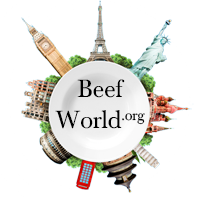In the modern global economy, supply chains are fragmented and complex. Every link in the chain is crucial, and any disruption can have a ripple effect throughout the network. In some regions — particularly Asia — this fragmentation makes it difficult to get an accurate picture of regional beef production statistics. However, what we do know is that regional beef production patterns are changing rapidly. In this blog post, we’ll explore the top 7 Asian countries with the highest beef production in 2018 as well as their forecast until 2024. Furthermore, we’ll cover recent trends and growth drivers for each country, so that you have all the information you need to make strategic partnerships in this growing market.
India
In India, beef production has remained stable in recent years, with 2018 output estimated at around 570,000 tonnes. India is the world’s second-largest producer of beef and has a well-developed cattle population. Despite a growing demand for beef, the country has traditionally been an exporter of the product, and it remains the top exporter of beef in Asia. The main region for beef production in India is the north-west, where various breeds of cattle are raised for both dairy and beef purposes. However, the country’s high population density and increasing urbanization have led to debates around the practice of cattle farming.
China
China is a major producer of beef and has seen production increase from 2.6 million tonnes in 2005 to nearly 3.3 million tonnes in 2018. Chinese beef production relies heavily on imported feed, which has led to increased prices for local farmers. As a result, China has increasingly replaced beef with domestic poultry production, particularly among smaller farmers. Nevertheless, Chinese beef production is projected to increase in the coming years. One of the factors that is expected to contribute to this is an increase in the Chinese population. The Chinese population is expected to grow from 1.4 billion in 2018 to 1.6 billion by 2024. As the middle class grows, there will be increased demand for beef, which is a high-priced protein source.
Indonesia
Indonesia’s annual beef production has fluctuated over the past decade, with output estimated at around 1.1 million tonnes in 2018. The country’s cattle sector is chiefly focused on supplying the domestic market. However, it also exports small volumes of chilled beef to Singapore. The Indonesian beef sector is highly fragmented, with small-scale farmers accounting for the majority of production. However, the recent rise in demand for beef in the country may lead to the development of more centrally controlled supply chains. Indonesia’s proximity to China and India, combined with its favorable climate, make it an attractive location for investors.
Philippines
The Philippines’ beef production has increased in recent years, reaching 683,000 tonnes in 2018. The country’s beef sector is dominated by major producers such as Alliance Group and JBF Philippines, which account for the majority of exports. The Philippines is a net importer of feed for cattle and other livestock species. The country imports about 80% of its feed requirements from other countries, most notably from Australia and the United States. However, the availability of feed from abroad has been reduced due to the trade dispute between the Philippines and China. The dispute has delayed shipments of feed from China and has caused higher prices.
Thailand
Thailand is Asia’s third-largest beef producer, with output estimated at 1.1 million tonnes in 2018. The country has a well-developed livestock sector, with large numbers of cattle and pigs raised on a commercial scale. In the past, the majority of Thailand’s beef was exported to its neighbouring countries, particularly Japan. However, in recent years, the country has focused on developing its domestic market, with the goal of attaining self-sufficiency in beef.
Vietnam
Vietnam’s livestock sector is growing, with annual output estimated at 1.8 million tonnes in 2018. The country has established itself as a leading exporter of pork in Asia and is a major poultry producer. Vietnamese authorities have set a target to increase the country’s beef production to 2 million tonnes by 2020. To achieve this goal, the government has introduced various incentives, including reduced taxes, to encourage investment in the sector. The country has also set a goal to become a major beef importer and achieved this in 2018. Vietnam imports a large proportion of its feed requirements from Australia and Brazil.
Malaysia
Malaysia’s beef production has remained stable in recent years, with output estimated at 1.1 million tonnes in 2018. The country’s beef sector is dominated by a small number of large-scale farms, many of which are engaged in cross-breeding activities. In Malaysia, the availability of feed for cattle is generally sufficient. However, feed availability can be hampered by transport issues, which can be problematic in areas that are located far from feed mills.
Conclusion
Asia is the most populous region in the world, and its consumers are rapidly becoming wealthier and more urbanized. This is leading to an increase in demand for high-protein foods such as beef, which is a significant source of nutrients such as iron and zinc. However, access to high-quality beef can be difficult and expensive in many Asian countries, and this has led to a rise in demand for lower-cost processed meat products such as sausages and burgers. In order to succeed in Asia’s beef market, companies need to understand their local customers’ preferences and purchase patterns. They also need to understand where their inputs are coming from as well as how to navigate the complex supply chain in the region.





